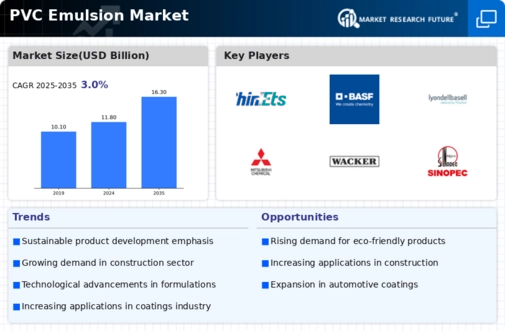Expansion of End-User Industries
The expansion of end-user industries is a critical factor propelling the PVC Emulsion Market. Sectors such as textiles, packaging, and consumer goods are increasingly adopting PVC emulsions for their unique properties and versatility. For instance, in the textile industry, PVC emulsions are utilized for coatings that enhance durability and water resistance. Market data reveals that the textile coatings segment is projected to grow at a rate of 5% annually, reflecting the increasing reliance on PVC emulsions. Additionally, the packaging industry is leveraging PVC emulsions for their ability to provide excellent barrier properties. As these end-user industries continue to expand, the demand for PVC emulsions is expected to rise correspondingly, thereby fostering growth within the market.
Innovations in Product Development
Innovations in product development are significantly influencing the PVC Emulsion Market. Manufacturers are increasingly focusing on enhancing the performance characteristics of PVC emulsions, such as improving adhesion, flexibility, and weather resistance. These advancements are often achieved through the incorporation of new additives and formulations that cater to specific application needs. For instance, the introduction of eco-friendly emulsions that reduce volatile organic compounds (VOCs) aligns with the growing demand for sustainable products. Market data indicates that the segment of eco-friendly PVC emulsions is expected to witness a growth rate of around 7% annually. This trend not only meets regulatory requirements but also appeals to environmentally conscious consumers, thereby expanding the market potential for innovative PVC emulsion products.
Rising Demand in Construction Sector
The PVC Emulsion Market is experiencing a notable surge in demand, particularly driven by the construction sector. As urbanization accelerates, the need for durable and versatile building materials becomes paramount. PVC emulsions are increasingly utilized in paints, coatings, and adhesives, which are essential for modern construction projects. According to recent data, the construction industry is projected to grow at a compound annual growth rate of approximately 5.5% over the next few years, thereby bolstering the demand for PVC emulsions. This growth is further supported by the material's favorable properties, such as resistance to moisture and chemicals, making it an ideal choice for various applications. Consequently, the expansion of the construction sector is likely to propel the PVC Emulsion Market forward, creating new opportunities for manufacturers and suppliers alike.
Increased Application in Automotive Industry
The automotive industry is emerging as a significant driver for the PVC Emulsion Market. With the ongoing shift towards lightweight materials to enhance fuel efficiency, PVC emulsions are being increasingly utilized in automotive coatings and interior applications. The versatility of PVC emulsions allows for a wide range of finishes and textures, which are essential for modern vehicle aesthetics. Recent statistics suggest that the automotive coatings segment is expected to grow at a rate of 4% per year, further solidifying the role of PVC emulsions in this sector. As automotive manufacturers continue to prioritize durability and performance, the demand for high-quality PVC emulsions is likely to rise, thereby contributing positively to the overall market dynamics.
Growing Awareness of Environmental Regulations
The PVC Emulsion Market is also being shaped by the growing awareness of environmental regulations. Governments and regulatory bodies are increasingly implementing stringent guidelines aimed at reducing the environmental impact of industrial processes. This has led to a heightened focus on the development of low-VOC and eco-friendly PVC emulsions. Manufacturers are now compelled to innovate and adapt their product lines to comply with these regulations, which may involve significant investment in research and development. Market analysis indicates that the demand for compliant products is likely to increase, as companies seek to align with sustainability goals. This regulatory influence not only drives innovation but also creates a competitive landscape where environmentally responsible products gain a market advantage.

















Leave a Comment